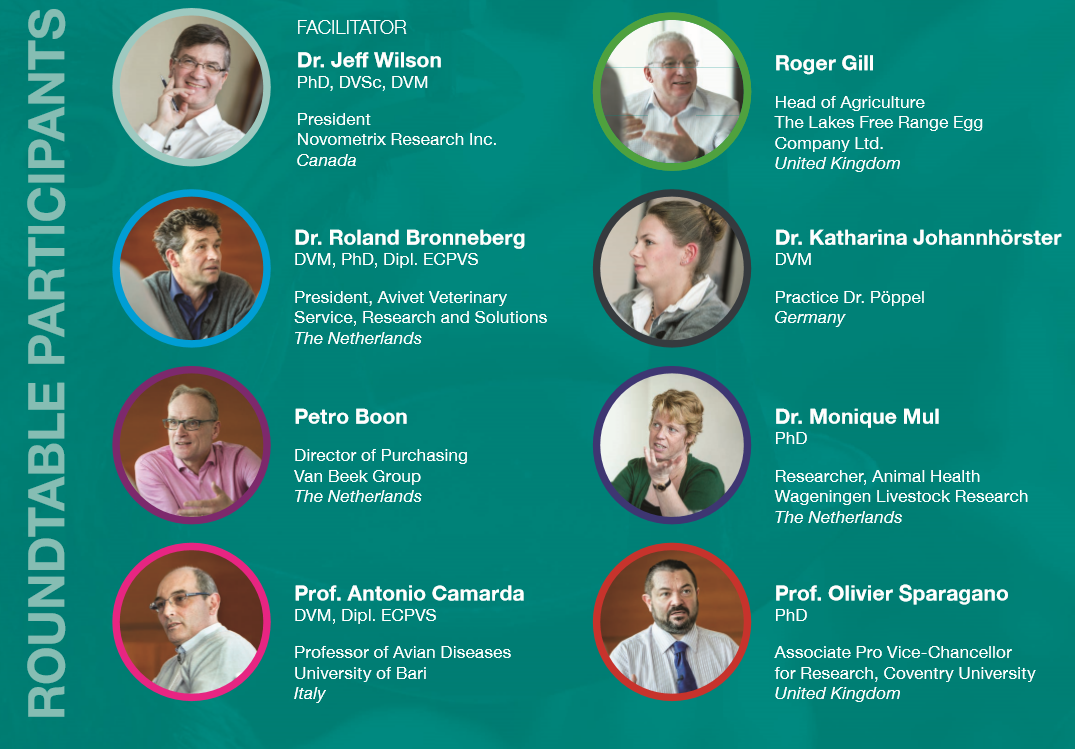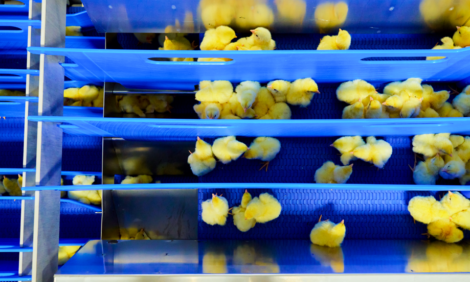



Poultry Red Mite expert roundtable
In order to facilitate information sharing between members of the full value chain including researchers, egg producers, industry (i.e., egg packers), and pharmaceutical companies, MSD Animal Health organized and sponsored a Poultry Red Mite Expert Roundtable in Amsterdam, Netherlands, on February 21, 2017.Introduction
The control of Dermanyssus gallinae, or the poultry red mite, is an emerging issue of great importance to the global egg production industry. Recently, a signi?cant amount of new research has been occurring both to aid in our understanding of poultry red mites and to develop new treatment methods.
The goal of the Poultry Red Mite Expert Roundtable was to enable information sharing, enhance educational opportunities, and identify solutions and next steps for the poultry egg industry to tackle the issue. The roundtable meeting was facilitated by Dr. Je? Wilson of Novometrix Research Inc. and attended by seven participants. The participants represented a number of sectors in the poultry value chain including researchers, veterinarians, egg production companies and egg packagers. This article highlights some of the stimulating answers and input received from participants during the roundtable meeting.
What is the prevalence of poultry red mites and awareness of the issue?
.PNG)
RG: Due to the structure of our housing systems, it can be difficult to see the mites, and farmers aren’t necessarily looking for them. We (as an egg production company) are interested in learning about ways that we can help farmers look for red mites in a structured and helpful way.
KJ: It is a huge problem, and many farmers do not recognize mites early in an infestation. Then they see their hens feather pecking and they don’t know why … we need to sensitize farmers to the issue so they are looking for red mites.
AC: Often farmers seem to be alone when it comes to controlling red mites … and the sensitivity of each farmer to the issue also seems to be different. The prevalence of red mites is very high; in Italy we see it in approximately 90% of farms.
OS: There also seems to be a stigma around the red mite issue. Farmers may not want to admit that they have a problem because they fear that the egg packers or retailers might not want to buy their eggs. Therefore, some farmers will deny that they have an issue because they are very fearful of the economic losses that may occur as a result. Need to create a community and allow for open communication with veterinarians so that producers feel comfortable talking about red mite issues.
RB: In order to show farmers the importance of the issue and get the message across, we need to link the red mite issue to performance. It would be very valuable if we could do a simple prevalence study across the EU and link with simple production measures (such as egg production and feed conversion) to show the economic impact of the red mites.
What is the impact of poultry red mites on production, health, welfare and profitability?
RG: On farms, we see variable production, pale combs, feather loss, and increased noise levels because birds are agitated. When it comes to financial performance levels, we tend to focus on egg numbers. For example, in a flock with 16,000 birds, if an egg is worth about 8 pence, that’s equal to about £1,280 across the whole flock (the cost of one egg lost in production). If we are experiencing a loss of 10 eggs, that is equal to £12,800 across the whole flock. This is a significant amount of money to the farmer.
MM: There is a significant economic impact for farmers through loss of production. We can prove that feed conversion is affected even in early stages when the infestation levels are lower. We’ve also all heard that products that are used aren’t always legal – as a result these may negatively affect animal health or result in residues in or on the egg. Also potential for an environmental impact through (chemical) residues in the manure.
PB: Cost-wise, it is a big economic issue in Germany and it is affecting producers in terms of feed conversion and other production problems, resulting in the farmer making less profit. As a company, we have seen some problems with second-class eggs due to blood spots; however, this does not appear to be a big issue at the moment.
RB: For me, the biggest impact is on profitability. It’s a direct impact but is caused indirectly, through production losses via stress, impact on immune status, and anemia. All of those things put together have a big impact on productivity. In terms of egg production, the impact is a decrease of 5-10 eggs for an average infestation. Additionally, we know that some conditions such as Gumboro Disease, Merek’s Disease, adenoviruses, etc., cause immunosuppression. I believe a red mite infestation acts in the same way, causing immunosuppression in the hen, making it more sensitive to other diseases such as Salmonella or E. coli. It is a complex disease.
What are some prevention and treatment considerations?
AC: In terms of prophylaxis or preventative treatments – while the barn is empty, it is possible to treat all the points in the cage that are difficult to reach. For example, it’s known that the perches are an area where mites tend to survive while the barn is empty. Also in older cages the ventilation tubes between cages are another area where mites tend to survive.
OS: There has been ongoing research into vaccine development for the past 8 years. In the lab we can see 80-90% reduction in red mite populations, but this doesn’t always translate into the field setting … There has been a lot of progress in the past 5 years: I expect that there will be a vaccine on the market in the next 10 years.
RB: Good treatment effect studies are not available for a lot of the products available in the field … We also need to consider issues of resistance, withdrawal times, and potential for residues on the eggs.
KJ: In Germany, there are only about 2-3 products that show good efficacy and sometimes we need to change the products because of resistance issues. We do a lot with silica dust for prevention but may use the chemicals as well, trying to save them for as late as possible. But the big gap is that there are only 2-3 products with good efficacy.
AC: In some cases, farmers will choose to use less expensive products that may be banned without understanding the effect of the product on eggs and potential of harmful residues for customers.
PB: We, as an egg packaging company, are very concerned about the illegal treatments that farmers might be using to deal with the red mite issue. In our contracts with producers, we have rules about only using legal products, including for pest control. We do some research on residues on eggs, and have not found problems in the past.
What about poultry red mite resistance to treatments?
OS: Development of resistance to chemical products, in general, is almost inevitable. We (as researchers and pharmaceutical companies) need to think in advance about resistance and how to tackle it when it happens. By considering this now and having a planned solution, we can help to keep products effective into the future.
RG: There is a need to educate farmers about the importance of proper application of treatments. Sometimes we see that producers are using products incorrectly, not because they don’t know how to use it, but because they are trying to cut costs by diluting a product or using a lower dose. But, they are not aware of the dangers in doing that – what the real cost is.
RB: That’s right. We also need to educate on how improper treatment application can lead to resistance development. If farmers try to use a lower dose to save money, then we might not have effective remedies anymore.
AC: Resistance to chemical acaricides (correctly or wrongly applied) has been reported in the field. To support farmers and veterinarians in choosing the most effective treatment, we can test the sensitivity of the mite population to be treated against specific molecules in vitro. This approach provides data that is useful when it comes to estimating expected results in the field, and at the same time, to support the choice of the best treatment.
How can we solve the poultry red mite problem?
AC: We need tools and monitoring programs that are specific to the conditions on individual farms. Also need a way to determine when it is economically most effective to start treatment. But before that, we also need to be working to develop prevention and prophylaxis methods, not just focusing on a chemical treatment approach. For example, considering the design of farms and cages, this is especially important with new regulations (in some countries) regarding cages.
RG: Looking forward, data collection is very important. If you ask a farmer what their production levels are, they will often ‘correct’ this in a way that alters the information. If we are able to collect data in an automated way, we get more accurate information on the effect of an infestation.
KJ: I think it is important to have more interaction between veterinarians and the producers. Sharing information on how to treat effectively, it is important to stress the importance of repeating the treatment every 7-10 days. Also important to discuss housing design, for example – design of the manure belt, something that is easy to change but needs to be considered before building the barn. Farther in the future, we need to develop new treatments, vaccines or chemical products with proven efficacy.
OS: Prevention is the area where we could make the biggest ‘win.’ There is an opportunity to increase education for the producers by giving simple recommendations of what to do and what not to do. This will minimize the frequency and number of outbreaks. Also need to make sure that the producers and veterinarians are on the same side and that the stigma around red mites is reduced. We need to increase trust with producers so that we can get more data and more cooperation to work together. For this, we need the entire sector on-board.
PB: I also agree about the need to increase awareness and prevention. We need to build up communication with farmers. This could occur through producer newsletters and other publications. For example, our company shares information using newsletters and direct letters. Also, there are a lot of people visiting farms. We need the feed representatives and veterinarians, etc. – all the people (involved at the farm) – to be part of the awareness and prevention plan. This is quick and easy and cheap to implement









.PNG)
.PNG)


